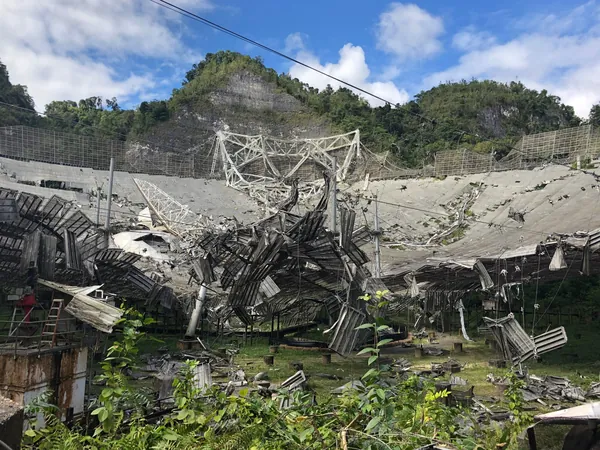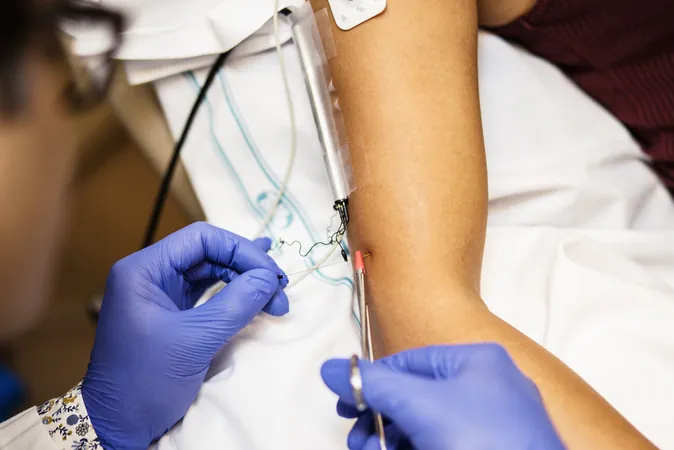
The Arecibo Observatory Tragedy: A Perfect Storm of Nature and Negligence
2024-10-31
Author: Arjun
Introduction
The once-majestic Arecibo Observatory in Puerto Rico met its tragic end not just due to the ravages of a hurricane, but also a shocking series of engineering oversights, according to a recently released report by the National Academies of Sciences, Engineering, and Medicine (NASEM). This detailed investigation highlights a catastrophic combination of natural disaster and human error that led to the downfall of one of the world's most iconic radio telescopes in late 2020.
The Collapse of Arecibo
The downfall of Arecibo, known for its 1,000-foot-wide dish that famously probed the mysteries of the universe, unfolded over a harrowing few months as multiple cables supporting its main platform failed. What the report distinctly underscores is the glaring lack of urgency from engineers and inspectors when warning signs began to emerge years before the collapse.
Aftermath of Hurricane Maria
Initially battered by Hurricane Maria in 2017, the observatory's structural integrity had already been compromised. Subsequent analysis suggests that the equipment failure observed at Arecibo is one of the most perplexing in modern engineering history. The report posits that while Hurricane Maria was indeed a catalyst, it was the unusual conditions related to Arecibo’s powerful radio transmissions that may have exacerbated the deterioration of crucial components, specifically the spelter sockets holding the cables.
Cables and Oversights
Evidence in the report reveals that the cables had been slipping out of their sockets since 2018 and 2019, yet those responsible for monitoring the site deemed the situation non-threatening. "An anomaly like this should raise all kinds of alarm," noted Habib Tabatabai, a structural engineering expert involved in the report. “Imagine a patient with a serious medical condition being overlooked because no one had seen anything like it before; it’s a dangerous precedent.”
Final Cable Failure
Arecibo’s final cable failure was recorded on December 1, 2020, when one last auxiliary cable snapped, resulting in the catastrophic crash of the 900-ton receiving platform into the dish below. Before this, two other cables had already succumbed to failure earlier that same year, escalating concerns about the observatory’s viability.
Failures in Communication
The engineering community is particularly troubled by the report’s findings regarding the failures in communication and oversight. Rather than addressing the critical socket slippage, repairs focused mistakenly on other areas, leaving the observatory vulnerable despite the urgent need for comprehensive evaluation of the cables.
Reactions from Experts
Ray Lugo, head of the Florida Space Institute, expressed disbelief at the oversight during committee discussions. Despite a lack of visible concern over the signals of impending failure, structural engineers, who were tasked with assessments after the hurricane, failed to recognize the severity of the cable slippage.
Zinc Creep Phenomenon
Significantly, the report mentions an unprecedented phenomenon known as "zinc creep." This process of metal deformation could not only have contributed to the cable failures observed at Arecibo but questions arise if such degradation could arise from the observatory’s powerful radio transmissions. This poses wider implications for future engineering projects, especially for structures utilizing similar materials under high electrical loads.
Impact on Scientific Community
As a community that relied heavily on Arecibo for astronomical research, scientists expressed profound sorrow and frustration over the telescopic loss. The observatory was instrumental for radio astronomy and contributed significantly to the search for extraterrestrial intelligence. Its collapse represents a long-term loss, not only of a facility but also of the unique scientific endeavors historically undertaken there.
Lessons Learned
The fate of Arecibo serves as a crucial warning to both engineers and policymakers alike. Habib Tabatabai’s research aims to uncover more about the relationship between electrical impulses and material integrity, potentially paving the way for safer engineering practices in the future.
Conclusion
In the wake of this tragedy, the Arecibo Observatory’s story stands as a stark reminder of how the forces of nature and human oversight can converge with devastating effects. It prompts an urgent call to prioritize infrastructure safety and to heed even the smallest signs of impending failure, lest we risk repeating the mistakes of the past.





 Brasil (PT)
Brasil (PT)
 Canada (EN)
Canada (EN)
 Chile (ES)
Chile (ES)
 España (ES)
España (ES)
 France (FR)
France (FR)
 Hong Kong (EN)
Hong Kong (EN)
 Italia (IT)
Italia (IT)
 日本 (JA)
日本 (JA)
 Magyarország (HU)
Magyarország (HU)
 Norge (NO)
Norge (NO)
 Polska (PL)
Polska (PL)
 Schweiz (DE)
Schweiz (DE)
 Singapore (EN)
Singapore (EN)
 Sverige (SV)
Sverige (SV)
 Suomi (FI)
Suomi (FI)
 Türkiye (TR)
Türkiye (TR)